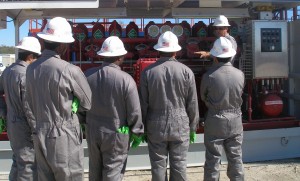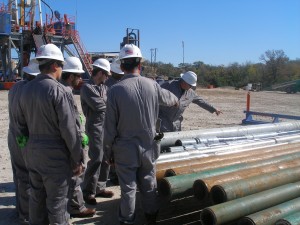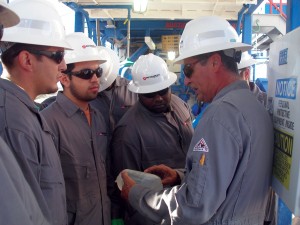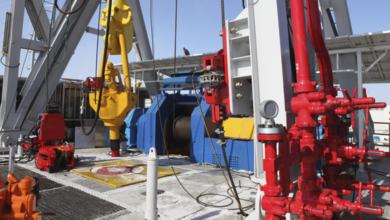HSE&T corner: Eight steps to grow the right people
By Joanne Liou, editorial coordinator
Manning a rig takes more than just having a person sign up to fill a position. The tasks at hand are not only physically demanding, but it takes someone who is competent to do the job while being invested in the team effort and in performing the tasks in the safest and most efficient manner. As the industry looks to a busy year of newbuilds and increased activity, hundreds of rig-based new-hires without any experience will join the industry’s work force. Companies face the daunting task of cultivating and retaining the newcomers – an ongoing challenge that is often reflected in high turnover rates.

“High floorhand turnover can be crippling to a drilling company committed to being in charge of its own destiny,” Cheryl Thomas, vice president of human resources at Patterson-UTI Drilling Co, said.
“We’ve seen floorhand turnover as high as 74%, with 26% of those leaving within the first 30 days. Exit interviews and turnover analysis have shown us that the people leaving were typically new to our industry, didn’t know what they were getting into and simply were not prepared for the challenges of working on a rig.”
To increase retention of new employees, Patterson-UTI Drilling set aside traditional training approaches and implemented a multifaceted program to grow their own employees who are right for the job.
“We’ve always liked to grow our own, which meant hiring inexperienced people and training them ourselves. We realized we had opportunities to do this more effectively. Now, we start with a focus on hiring the right inexperienced person with core behaviors and skills suited for success in our business,” she said.
Patterson-UTI Drilling’s New to Ind-ustry Drilling Competency Development program was implemented in the Permian Basin in September 2011. By the end of that year, the program had almost 200 participants. “We’ve reduced our turnover rate of newly hired floorhands from 26% to only 4%,” she added.
Sharing tactics from the development program, Ms Thomas shares eight steps to grow your own people and retain them.

1. Hire the right people
Growing the right people starts with hiring the right people. That means you have to identify what “right” means and always hire to that standard. When identifying what is right, be sure to factor in what is wrong.
“When we analyzed the reasons why employees fail, we realized that the root cause was more often behavior-based than a lack of skill,” Ms Thomas explained.
“One of the first things we do is to eliminate candidates with behaviors that are wrong for us.” All new-to-industry candidates must qualify for hire by passing a pre-employment survey, which helps identify if a person possesses high-risk behaviors, including drug or alcohol abuse, theft, hostility and lying.
2. Engage site leaders in the hiring process
After human resources finds and qualifies inexperienced candidates, drilling superintendents should become fully involved with the next step: a behavioral-based interview.
“After the pre-employment survey helps eliminate the wrong behaviors, we still have a lot of work to do to be sure candidates have the right behaviors,” Ms Thomas said. “It’s important that operations conducts the interview and selects the candidate for hire. Owning the interview and selection process helps ensure the right person is chosen, and it helps operations be invested in their people.”
Drilling superintendents are trained to conduct the behavioral-based interviews, which can be particularly effective because it discovers what a person has actually done in the past versus hypothetical information.
“The philosophy around these interviews is that past success is the greatest indicator of future success,” Ms Thomas explained.

3. Educate them
Before putting an inexperienced employee to work on a rig, make sure you have provided a solid educational foundation that is effectively transferred to performance on the job. “A traditional method of unstructured on-the-job training leaves too much to chance, which can result in gaps in knowledge and skills,” she said.
Patterson-UTI Drilling’s program starts with formal classroom education. “Our classroom education starts with a combination of e-learning modules from PETEX on the systems of a drilling rig, followed by facilitated instruction on the PPE, hazard identification and safe work practices associated with each system,” Ms Thomas said.
To reinforce the lesson, they engage participants using a training method called “See One, Do One, Teach One.” For example, in a lesson about the hoisting system, the class completes e-learning on computers followed by an instructor’s lesson. “The instructor goes over the PPE associated with the hoisting system,” Ms Thomas explained. “Since that’s going to involve heights, we teach them about fall protection.”
In the first step of the training method, the instructor shows the class what fall protection is, how to check it and how to put it on. Then the class puts it on and performs the check. The last step involves students teaching it back to each other. “One of the best ways to reinforce something you’ve learned is to teach it,” Ms Thomas stated.

4. Train them
Once the classroom portion of training is complete, the next step is on-the-job training (OJT). Instead of letting the new-hires free on the first day and hope they will be able to learn from others, provide a structured and supportive environment for OJT. “We educate them in a classroom on the basics,” Ms Thomas explained. “Now they’re going to take it and transfer it through OJT, cognitive to performance.”
In structured OJT, new-hires are assigned to operating rigs with certified training crews who lead trainees through the process of transferring what they were taught in class to competently performing. Patterson-UTI Drilling’s five-man training crews, plus a rig manager, complete a classroom course to understand what their new-to-industry employees will learn, in addition to a class on how to train using the “See One, Do One, Teach One” method. Training crews are provided with a toolkit of what to teach over the course of 11 days, and a drilling superintendent observes the competencies and performances before trainees graduate to become floorhands, Ms Thomas said.
5. Follow up
Regularly communicate with training crews and trainees so you know how OJT is progressing and to address potential problems early. It is important to stay in contact with recent graduates to reinforce their sense of belonging to the company. “Unless there’s some type of intentional outreach to communicate with these employees, it’s easy for them to feel isolated and not realize that they are an important part of our big picture,” Ms Thomas said.
Human resources can play a role and establish effective relationships with employees, and let them know they have advocates who are there to help resolve issues that may arise. “We want to know what’s going right on our rigs,” Ms Thomas stated. “We want to know what they think we should be doing differently and how we can help.”
6. Provide opportunities for growth
Traditionally, chances of a promotion depended on somebody higher up in the crew getting promoted or leaving. Facilitate promotional opportunities to help grow and retain your own.
“In the past, if you had an assistant driller (AD) on your rig, you stayed an AD until one of the drillers on that rig got promoted or quit,” Ms Thomas explained. Instead of confining employees to their specific rig, widen the scope of their opportunities beyond their rig or assigned superintendent by regularly and intentionally reviewing who is ready for promotion against available opportunities.
“If Rig 1 has an AD that is competent and ready to go and Rig 50 has an opening, we consider moving him to that opening,” Ms Thomas said. “This is especially important now because our development program is providing us with highly qualified people who are ready for promotion much sooner than what we’ve experienced in the past. If we don’t provide them opportunities for growth, we risk losing them and the great investment that we’ve made in them.”
7. Empower – and expect – leaders to lead
“We can grow the best people in the world all day long,” Ms Thomas said, “but if they’re not being led effectively and powerfully, they’re not going to stay. People leave people, not companies.” The leadership of a rig manager helps set the tone for growth and development among the crew. The role of the rig manager needs to focus on developing the crew and knowing how to facilitate that growth.
While many of the standard competencies are operational based, the competencies of a rig manager should be more behavioral and relationship oriented. “It’s our responsibility to set expectations and empower our rig managers and superintendents to lead,” she added.
8. There is no end to growing and learning
The process of growing the right people does not simply end after successful completion of the development program; it is ongoing with sustainment training and reinforcement.
In the military, soldiers are constantly sent to sustainment training to reinforce skills. “They’re in combat, and they still have to go through firearm sustainment training,” she said. “Growing your own is a journey; it is not a destination. You’re never done.”
The industry is constantly growing and changing, and it is important that companies respond with a learning culture. “Our people can adapt and learn, adapt and learn and apply it to performance on the job,” Ms Thomas added. “It’s the energy you get from the fact that it’s constantly moving.”
Conclusion
As new employees join the industry, it’s important to develop them from the start. A high turnover in an entry-level position can have detrimental effects in the long run. “If you’re having mass turnover in your floorhands so you’re always having to bring new people in, you’re never going to be able to develop a high-performing, engaged work force,” Ms Thomas stated.
The concept of growing your own emphasizes that a company has the potential to enrich the careers of their employees while cultivating a work force with the right people. “It’s not people who are our most important asset; it’s the right people,” she said.
This article is based on a presentation at the 2012 IADC Health, Safety, Environment & Training Conference & Exhibition, 7-8 February, Houston.



